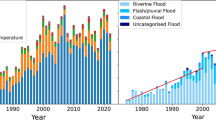Abstract
Commercially available natural catastrophe (cat) models have significantly improved the decision-making processes utilized by the insurance industry to price and manage cat risk. However, lack of historical loss data, and the need to make a large number of assumptions during the course of development of such models can lead to material biases in their outputs. It is crucial that insurance companies identify these sources of biases and adequately adjust the model outputs. In this study, we present methods that can be utilized for performance evaluation of cat models independent of the underlying peril or region. We illustrate the application of the proposed tests by reviewing two commercially available Japan Typhoon cat models (referred as models A and B) and evaluating their performance in quantifying commercial and industrial property losses. We have identified important limitations in both models including not accounting for storm surge and model specification uncertainty. We observed significant differences between the modeled losses for commercial exposures and uncertainty estimates for the corresponding event losses. Performed sensitivity tests indicate potential inconsistencies in Model B’s assumptions related to the quantification of loss severities across geographic regions, the estimation of contents and business interruption losses, and modeling of inland flooding. Additionally, our comparisons indicate that Model B assumes typhoon landfall frequencies significantly lower than historically observed values. Conducting the proposed tests on Model A also suggests potential underestimation of the losses for both the strongest category of typhoons and typhoons with losses primarily driven by rain-induced flooding. While modeling companies recognize some of these potential limitations and plan to address them in their next updates, it is important that they continue providing increased flexibility in adjusting model parameters and allow insurance companies to develop their own views in management and pricing of cat risks.













Similar content being viewed by others
Notes
In this manuscript, typhoons are categorized based on their central pressure instead of sustained wind speeds as currently done in Saffir-Simpson wind scale (NHC 2015). For example, category 3, 4, and 5 typhoons are defined as those with central pressures 964–945, 944–920, and <920 mb, respectively.
References
Aslani H, Miranda E (2005) Probabilistic earthquake loss estimation and loss disaggregation in buildings. In: Blume J (ed) Earthquake engineering center report no. 157, Stanford University, Stanford, CA
Baker JW, Cornell CA (2005) Vector-valued ground motion intensity measures for probabilistic seismic demand analysis. In: Blume A (ed) Earthquake engineering center report no. 150, Stanford University, Stanford, CA
Cole C, Macpherson D, McCullough K (2010) A comparison of hurricane loss models. J Insur Issues 33:31–53
Cornell CA, Krawinkler H (2000) Progress and challenges in seismic performance assessment. Pac Earthq Eng Res Center (PEER) News 3(2):1–3
Digital Typhoon (2014) Digital typhoon: Typhoon images and information. http://agora.ex.nii.ac.jp/digital-typhoon/. Accessed 1 Aug 2014
Dumm RE, Johnson M, Simons M (2009) Inside the black box: evaluating and auditing hurricane loss models. J Insur Regul 27(2):41–59
Florida Commission on Hurricane Loss Projection Methodology (FCHLPM) (2013) 2013 Meeting materials. http://www.sbafla.com/methodology/Meetings/PreviousYears/2013MeetingMaterials/tabid/1696/Default.aspx. Accessed 30 Mar 2015
Grossi P, Kunreuther H, Windeler D (2005) Chapter 2: an introduction to catastrophe models and insurance. In: Kunreuther H, Grossi P (eds) Catastrophe modeling a new approach to managing risk. Springer, Berlin, pp 23–42
Haselton C, Deierlein G (2007) Assessing seismic collapse safety of modern reinforced concrete moment frame buildings. In: Blume J (ed) Earthquake engineering center report No. 156, Stanford University, Stanford, CA
Higaki M, Hayashibara H, Nozaki, F (2009) Outline of the storm surge prediction model at the Japan Meteorological Agency. RSMC Tokyo-Typhoon Center Technical Review, Tokyo
Japan Meteorological Agency (JMA) (2014a) RSMC Tokyo: Typhoon Center best-track data. http://www.jma.go.jp/jma/jma-eng/jma-center/rsmc-hp-pub-eg/trackarchives.html. Accessed 1 Aug 2014
Japan Meteorological Agency (JMA) (2014b) Ranking of typhoons by pressure at landfall. http://www.data.jma.go.jp/fcd/yoho/typhoon/statistics/ranking/air_pressure.html. Accessed 1 Aug 2014
Kircher CA, Reitherman RK, Whitman RV, Arnold C (1997) Estimation of earthquake losses to buildings. Earthq Spectra 13(4):703–720
Kitamoto A (2014) Personal communication
Lin Y, Zhao M, Zhang M (2015) Tropical cyclone rainfall area controlled by relative sea surface temperature. Nat Commun 6:6591. doi:10.1038/ncomms7591
National Hurricane Center (NHC) (2015) Saffir-Simpson hurricane wind scale. http://www.nhc.noaa.gov/aboutsshws.php. Accessed 18 Mar 2015
National Institute of Building Sciences (NIBS) (1997) HAZUS: earthquake loss estimation methodology, Washington, DC
Peduzzi P, Chatenoux B, Dao H, De Bono A, Herold C, Kossin J, Mouton F, Nordbeck O (2012) Global trends in tropical cyclone risk. Nat Clim Chang 2:289–294
Pinelli J-P, Gurley KR, Subramanian CS, Hamid SS, Pita GL (2008) Validation of a probabilistic model for hurricane insurance loss projections in Florida. Reliab Eng Syst Saf 93(12):1896–1905
Simons MM, Evans JL, Zadeh, MM (2013) Evaluation of hurricane catastrophe models used in South Carolina. http://www.doi.sc.gov/DocumentCenter/View/7184. Accessed 30 Mar 2015
Zagrodik JP, Jiang H (2013) Comparison of TRMM precipitation radar and microwave imager rainfall retrievals in tropical cyclone inner cores and rainbands. J Geophys Res Atmos 118:29–42
Zareian F, Krawinkler H (2009) Simplified performance based earthquake engineering. In: Blume J (ed) Earthquake engineering center report no. 169, Stanford University, Stanford, CA
Zhe I, Jie B, Wen-Jun Z, Jun Y (2012) Analysis of tropical cyclone precipitation for different intensity class in Northwest Pacific with TRMM data. In: 2012 Asia Pacific conference on environmental science and technology (APEST 2012) 6:179–184
Author information
Authors and Affiliations
Corresponding author
Rights and permissions
About this article
Cite this article
Karaca, E., Aslani, H. Review of two Japan Typhoon catastrophe models for commercial and industrial properties. Nat Hazards 83, 19–40 (2016). https://doi.org/10.1007/s11069-016-2340-y
Received:
Accepted:
Published:
Issue Date:
DOI: https://doi.org/10.1007/s11069-016-2340-y




